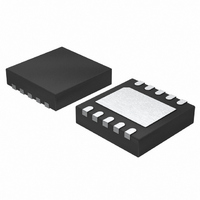C8051F523A-IM Silicon Laboratories Inc, C8051F523A-IM Datasheet - Page 98

C8051F523A-IM
Manufacturer Part Number
C8051F523A-IM
Description
IC 8051 MCU 4K FLASH 10DFN
Manufacturer
Silicon Laboratories Inc
Series
C8051F52xr
Specifications of C8051F523A-IM
Program Memory Type
FLASH
Program Memory Size
4KB (4K x 8)
Package / Case
10-DFN
Core Processor
8051
Core Size
8-Bit
Speed
25MHz
Connectivity
LIN, SPI, UART/USART
Peripherals
Brown-out Detect/Reset, POR, PWM, Temp Sensor, WDT
Number Of I /o
6
Ram Size
256 x 8
Voltage - Supply (vcc/vdd)
1.8 V ~ 5.25 V
Data Converters
A/D 6x12b
Oscillator Type
Internal
Operating Temperature
-40°C ~ 125°C
Processor Series
C8051F5x
Core
8051
Data Bus Width
8 bit
Data Ram Size
256 B
Interface Type
SPI/UART
Maximum Clock Frequency
25 MHz
Number Of Programmable I/os
6
Number Of Timers
3
Maximum Operating Temperature
+ 125 C
Mounting Style
SMD/SMT
3rd Party Development Tools
PK51, CA51, A51, ULINK2
Development Tools By Supplier
C8051F500DK
Minimum Operating Temperature
- 40 C
On-chip Adc
6-ch x 12-bit
Lead Free Status / RoHS Status
Lead free / RoHS Compliant
For Use With
336-1488 - KIT DEV C8051F53XA, C8051F52XA770-1006 - ISP 4PORT FOR SILABS C8051F MCU336-1455 - ADAPTER PROGRAM TOOLSTICK F520
Eeprom Size
-
Lead Free Status / Rohs Status
Lead free / RoHS Compliant
Other names
336-1491-5
C8051F52x/F52xA/F53x/F53xA
10. Interrupt Handler
The C8051F52x/F52xA/F53x/F53xA family includes an extended interrupt system with two selectable pri-
ority levels. The allocation of interrupt sources between on-chip peripherals and external input pins varies
according to the specific version of the device. Each interrupt source has one or more associated interrupt-
pending flag(s) located in an SFR. When a peripheral or external source meets a valid interrupt condition,
the associated interrupt-pending flag is set to logic 1.
If interrupts are enabled for the source, an interrupt request is generated when the interrupt-pending flag is
set. As soon as execution of the current instruction is complete, the CPU generates an LCALL to a prede-
termined address to begin execution of an interrupt service routine (ISR). Each ISR must end with an RETI
instruction, which returns program execution to the next instruction that would have been executed if the
interrupt request had not occurred. If interrupts are not enabled, the interrupt-pending flag is ignored by the
hardware and program execution continues as normal. (The interrupt-pending flag is set to logic 1 regard-
less of the interrupt's enable/disable state.)
Each interrupt source can be individually enabled or disabled through the use of an associated interrupt
enable bit in the Interrupt Enable and Extended Interrupt Enable SFRs. However, interrupts must first be
globally enabled by setting the EA bit (IE.7) to logic 1 before the individual interrupt enables are recog-
nized. Setting the EA bit to logic 0 disables all interrupt sources regardless of the individual interrupt-
enable settings. Note that interrupts which occur when the EA bit is set to logic 0 will be held in a pending
state, and will not be serviced until the EA bit is set back to logic 1.
Some interrupt-pending flags are automatically cleared by the hardware when the CPU vectors to the ISR.
However, most are not cleared by the hardware and must be cleared by software before returning from the
ISR. If an interrupt-pending flag remains set after the CPU completes the return-from-interrupt (RETI)
instruction, a new interrupt request will be generated immediately and the CPU will re-enter the ISR after
the completion of the next instruction.
10.1. MCU Interrupt Sources and Vectors
The C8051F52x/F52xA/F53x/F53xA MCUs support 15 interrupt sources. Software can simulate an inter-
rupt by setting any interrupt-pending flag to logic 1. If interrupts are enabled for the flag, an interrupt
request will be generated and the CPU will vector to the ISR address associated with the interrupt-pending
flag. MCU interrupt sources, associated vector addresses, priority order, and control bits are summarized
in Table 10.1 on page 99. Refer to the data sheet section associated with a particular on-chip peripheral for
information regarding valid interrupt conditions for the peripheral and the behavior of its interrupt-pending
flag(s).
10.2. Interrupt Priorities
Each interrupt source can be individually programmed to one of two priority levels: low or high. A low prior-
ity interrupt service routine can be preempted by a high priority interrupt. A high priority interrupt cannot be
preempted. Each interrupt has an associated interrupt priority bit in an SFR (IP or EIP1) used to configure
its priority level. Low priority is the default. If two interrupts are recognized simultaneously, the interrupt with
the higher priority is serviced first. If both interrupts have the same priority level, a fixed priority order is
used to arbitrate, given in Table 10.1.
10.3. Interrupt Latency
Interrupt response time depends on the state of the CPU when the interrupt occurs. Pending interrupts are
sampled and priority decoded each system clock cycle. Therefore, the fastest possible response time is 5
system clock cycles: 1 clock cycle to detect the interrupt and 4 clock cycles to complete the LCALL to the
ISR. If an interrupt is pending when a RETI is executed, a single instruction is executed before an LCALL
is made to service the pending interrupt. Therefore, the maximum response time for an interrupt (when no
other interrupt is currently being serviced or the new interrupt is of greater priority) occurs when the CPU is
performing an RETI instruction followed by a DIV as the next instruction. In this case, the response time is
98
Rev. 1.3










